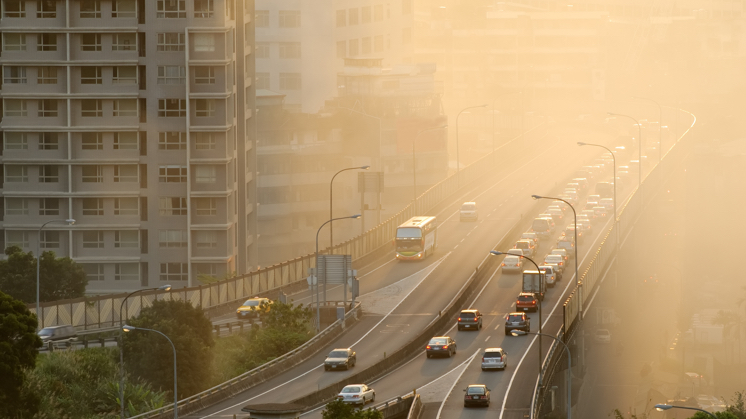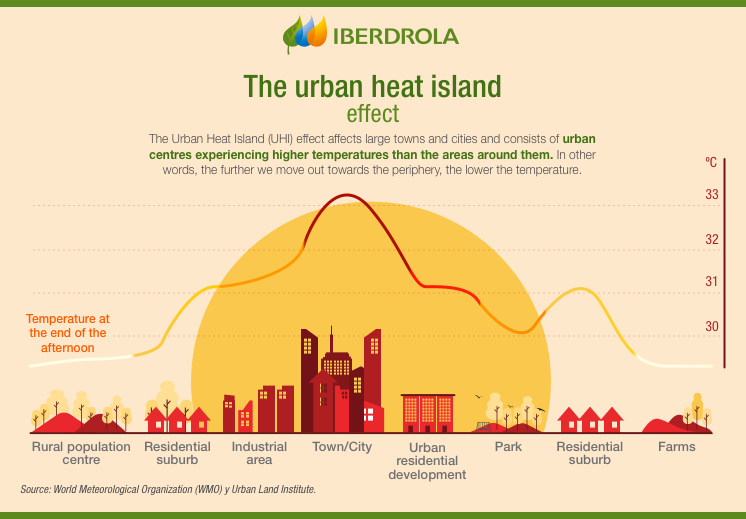URBAN HEAT ISLAND
Urban heat islands and their adverse effects on their inhabitants
Why is it warmer in a large town or city than in a village located only a few miles outside it? The answer lies in what are known as heat islands. This thermal phenomenon, which raises the temperature in urban areas —especially at night—, can be attributed to several factors: elements that give off heat, such as HVAC systems, or the construction materials used, including asphalt. In addition, they exacerbate climate change and negatively affect health.

Climate change threatens both large population centres and natural environments. In fact, extreme weather events such as heatwaves and droughts are becoming ever more commonplace and are causing health and water supply problems. Despite trends including counterurbanization, the number of town and city dwellers will continue to rise over the next few decades, resulting in megacities where phenomena like urban heat islands, which we will be discussing below, may be exacerbated.
What is an urban heat island
Heat islands are a phenomenon that occurs in urban areas as they experience higher temperatures than the areas around them due to human activity. The main reason is the presence of structures, such as buildings, pavements and streets, that absorb more heat and release it more slowly than natural habitats such as forests, rivers and lakes. Added to this is the heat and contamination generated by traffic and industry. All of this exacerbates the consequences of climate change in towns and cities and lowers the quality of life of their inhabitants.
The urban heat island effect
The heat island effect is characterised, as we have already mentioned, as being the cause of higher temperatures in towns and cities than in their surrounding areas —villages, suburban residential developments, agricultural area, etc.— and is more pronounced at night, above all in winter. The average annual air temperature in a city with a million and a half plus inhabitants can be between 1 °C and 3 °C higher during the day with respect to its surrounding area, while at night that difference can be even greater, even by up to 10 °C.

 SEE INFOGRAPHIC: The urban heat island effect [PDF] Enlace externo, se abre en ventana nueva.
SEE INFOGRAPHIC: The urban heat island effect [PDF] Enlace externo, se abre en ventana nueva.
Causes of urban heat islands
There are several causes that contribute to the generation of urban heat islands and raise the temperature in towns and cities. Of these, the most important are:
- Dark, high heat-conductive surfaces, such as asphalt —which, furthermore, are used by a greater number of vehicles within urban areas—, mean that towns and cities absorb more solar radiation during the day than a rural area.
- The lack of vegetation and green areas in cities, such as urban parks, are the reason why the temperature does not drop due to the evaporation of water from plants. What is more, fewer trees means less shade, which means the ground in cities heats up more.
- The large buildings, be they office blocks or private apartments, that make up cities absorb heat and block out the wind, thus preventing air currents from refreshing the atmosphere. This is why it is important to build sustainable buildings that take these variables into account.
- Atmospheric pollution, caused by factories, vehicles and HVAC systems, among others, trap the solar radiation, thereby preventing the heat from dissipating, which, in turn, raises the temperature of the air.
Consequences of urban heat islands
Urban heat islands have negative consequences on people's lives and the environment:
![]() Higher energy consumption
Higher energy consumption
The temperature in cities is higher, especially on summer nights. This generates an increase in the demand for energy to power air-conditioning units, which in turn drives up the price of electricity.
![]() Impact on health
Impact on health
The high temperatures can affect the health of city dwellers, causing widespread discomfort, respiratory problems, sunstroke, dehydration, tiredness and even increasing mortality rates due to heatstroke.
![]() Greater atmospheric contamination
Greater atmospheric contamination
Heat islands worsen air quality, given the fact that in tandem with the increased consumption of fossil fuels they add to the emission of CO2 and other contaminants, such as sulphur dioxide (SO2) and nitrogen oxides (NOx), which are to blame for the greenhouse effect.
![]() Impact on the economy
Impact on the economy
A recent study , published by IOP Publishing, indicates that the effects associated with the warming caused by urban heat islands could double foreseen economic losses due to climate change.
, published by IOP Publishing, indicates that the effects associated with the warming caused by urban heat islands could double foreseen economic losses due to climate change.
Solutions to urban heat islands
In order to minimise the impacts of urban heat islands it is necessary to commit to sustainable urban development, as has been called for by the UN via its New Urban Agenda. These solutions include:
- Bioclimatic architecture: including the installation of renewable energy, such as solar panels, to encourage photovoltaic self-consumption or green roofs to mitigate heat absorption, as well as passive cooling elements to create more efficient houses.
- Sustainable infrastructure: cities need to renew their buildings, roads, bridges, pavements, stations, street lights, among other elements, so as to bring them into line with the fight against climate change. The fact is that they are essential for underpinning green economic growth.
- Sustainable mobility: vehicle traffic is one of the main causes of urban pollution, which in turn contributes to rises in temperatures. It is for this reason that mobility must look to the future and, hand-in-hand with the new technologies, drive initiatives such as Mobility as a Service (MaaS).
- Green taxes: the taxes on the emission of CO2, of other greenhouse gases and of contaminating substances are designed to penalise non-environmentally friendly behaviour and compensate for the externalities relating to the economic development of cities.
- Eco-neighbourhoods: we are talking about new urban developments that set out to reduce the impact on the environment by changing the life habits of their inhabitants. This could be done by incorporating more green areas, regenerating public spaces and promoting environmental education.
- Green corridors: these areas, which also have different social, cultural or sporting uses, enable natural areas in a city to be connected via extensive swathes of vegetation. At this point it is also worth mentioning elements such as urban gardening.




